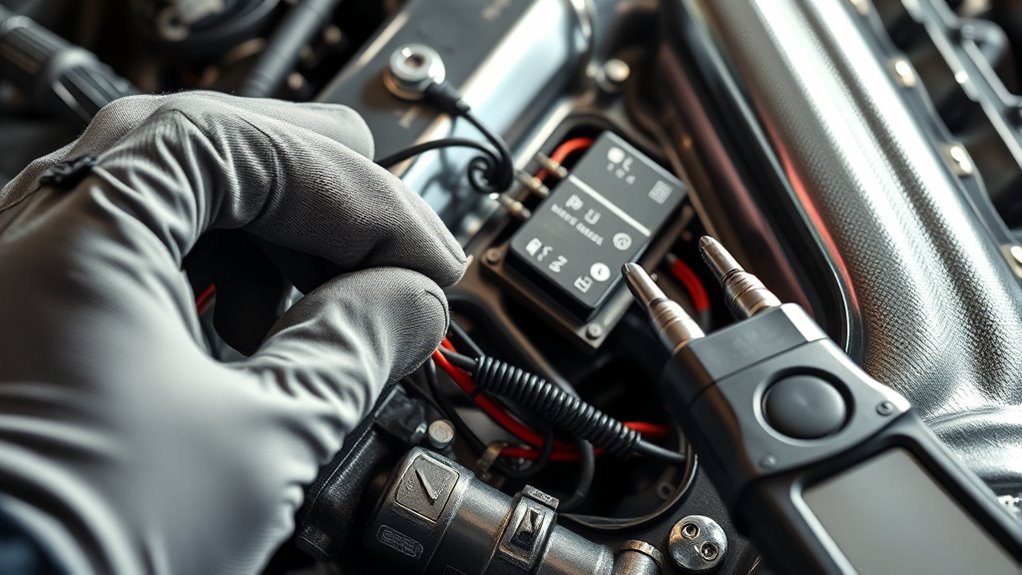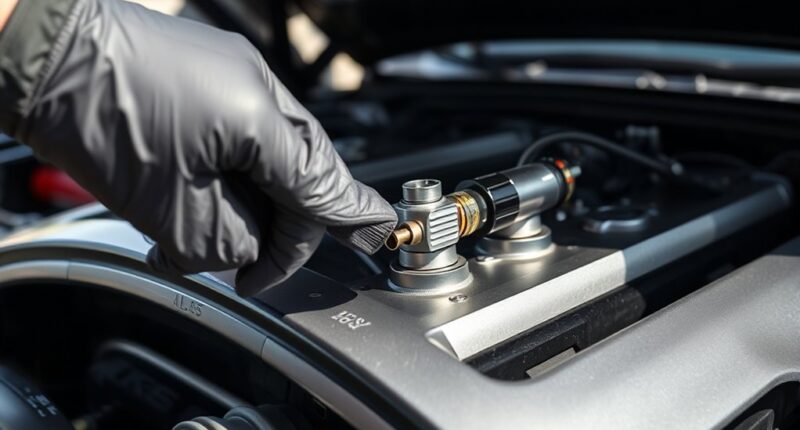To diagnose false knock sensor alarms in your LS engine, start by inspecting the wiring harness for cracks, corrosion, or loose connections. Next, check the sensor’s resistance with a multimeter to guarantee it’s within manufacturer specs. If wiring looks good, reprogram or update your ECU to fix any firmware issues. Replacing the sensor might be necessary if it sends erratic signals. Continue with these tips to uncover more effective solutions and get your engine running smoothly.
Key Takeaways
- Inspect wiring harness for damage, corrosion, or loose connections, and test continuity with a multimeter.
- Verify and update ECM firmware; reprogram or recalibrate ECM sensitivity settings as needed.
- Test the knock sensor for erratic signals; replace if faulty or damaged.
- Clear fault codes after wiring repairs or sensor replacement to confirm proper operation.
- Regularly inspect wiring and keep ECM software up to date to prevent false alarms.

If your LS engine is triggering false knock sensor alarms, it can be frustrating and confusing. These false alarms often stem from issues with sensor wiring or problems within the ECM programming. The knock sensor plays an essential role in detecting engine knocking or pinging, so when it sends incorrect signals, the engine control module (ECM) may interpret this as a real knock, leading to unnecessary alarms or even engine performance issues. Understanding how to diagnose and address these problems starts with inspecting the sensor wiring. Over time, wiring can become brittle, corroded, or damaged, which causes intermittent or false signals. You should carefully examine the wiring harness connected to the knock sensor, looking for cracked insulation, loose connectors, or corrosion. Replacing damaged wiring or securing loose connections often resolves false alarms caused by electrical issues.
Beyond wiring, ECM programming can also be be a culprit. Sometimes, the engine’s computer isn’t properly calibrated to interpret signals from the knock sensor, especially after modifications or software updates. In such cases, reprogramming or reflashing the ECM might be necessary to correct the sensor’s input interpretation. Many engine control modules allow for software updates via tuning tools or dealership diagnostics, which can recalibrate the sensor thresholds and eliminate false alarms. It’s vital to verify your ECM is running the latest firmware compatible with your vehicle, as outdated or incorrect programming can cause the ECM to misread legitimate signals or generate false positives. Additionally, understanding a common issue related to sensors can help in diagnosing the root of false alarms more effectively.
When troubleshooting, start by disconnecting the knock sensor and testing the wiring with a multimeter. Check for continuity and proper resistance levels as specified in your vehicle’s service manual. If the wiring tests fine, reconnect everything and consider performing a sensor reset or ECM reset to clear any stored fault codes. If the alarm persists, it’s worth replacing the sensor itself, as a faulty sensor can send erratic signals even if wiring is intact. After replacing the sensor, ensure the ECM is properly reprogrammed or reset to recognize the new sensor signals. Sometimes, sensor signals are overly sensitive due to factory settings, so tuning the ECM to adjust the sensitivity can prevent future false alarms.
Frequently Asked Questions
Can a Faulty Knock Sensor Cause Engine Misfires?
A faulty knock sensor can cause engine misfires because it sends incorrect signals, triggering unnecessary adjustments in engine timing. This can lead to unusual engine noise and decreased fuel efficiency. When the sensor malfunctions, your engine might misfire or run rough, especially under load. To prevent damage and maintain peak performance, it’s essential to diagnose and replace a faulty knock sensor promptly.
How Long Does It Take to Replace an LS Engine Knock Sensor?
Replacing your LS engine knock sensor typically takes about 1 to 2 hours, depending on your experience and tools. You’ll need to follow the replacement procedures carefully, including disconnecting the sensor and guaranteeing proper sensor calibration afterward. Take your time to access the sensor, replace it correctly, and verify the system’s response. Proper calibration ensures your engine runs smoothly and prevents false alarms or misfires.
Are Aftermarket Knock Sensors Reliable for LS Engines?
You’re wondering if aftermarket options are reliable for LS engines. Many aftermarket knock sensors can be compatible, but quality varies. You should look for sensors with solid sensor compatibility and good reviews. Some brands offer reliable performance, but cheaper options might cause false alarms or poor durability. It’s best to research specific models and verify they meet OEM standards to avoid future issues with your LS engine.
What Are Common Signs of a Failing Knock Sensor?
Ever notice your engine making strange noises or running rough? Those are common signs of a failing knock sensor. When the sensor malfunctions, it can’t detect engine knocking properly, leading to abnormal engine sounds and potential power loss. You might also see a check engine light or experience decreased fuel efficiency. If you notice these issues, it’s time to check the sensor, as these symptoms point to sensor malfunction and the need for replacement.
Is It Safe to Drive With a False Knock Sensor Warning?
Driving with a false knock sensor warning isn’t safe because it can affect engine performance and lead to potential driving risks. While it might seem okay temporarily, the sensor’s false alert could hide underlying issues or cause the engine to run inefficiently. For knock sensor safety, it’s best to get it checked promptly. Ignoring the warning might cause more damage, making repairs costlier and risking your vehicle’s reliability.
Conclusion
While false alarms from your LS engine’s knock sensor can be frustrating, thorough diagnosis and proper sensor replacement usually resolve the issue. Don’t dismiss these alerts as mere nuisances; they could mask underlying problems that, if ignored, might lead to more serious engine damage. Taking the time to accurately diagnose ensures you’re not overpaying for unnecessary repairs and keeps your engine running smoothly. With patience and proper tools, you’ll prevent future false alarms and maintain peak performance.










